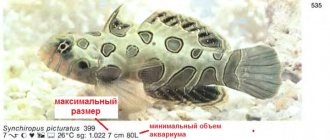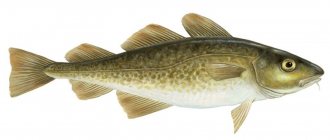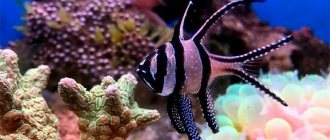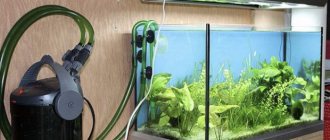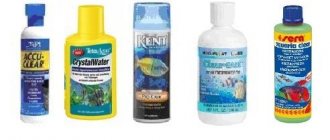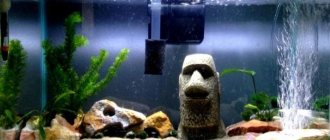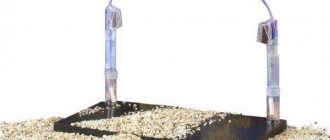An aquarium is a complex biological system limited by artificial boundaries, which is in constant dynamics. Various changes and fluctuations in the aquarium ecosystem are caused by a number of internal and external factors. That is why the water, plants and animals of the aquarium need constant monitoring and support. In addition to feeding the flora and fauna, as well as periodically cleaning the aquarium, the aquarist is faced with other, much more difficult tasks. For example, fish and plants periodically get sick, which means they require treatment and additional care. In addition, in almost any aquarium there is a problem of uncontrolled algae proliferation. We will talk about this problem, as well as ways to overcome it, in this article.
Mechanism of action of Sidex
Solutions of glutaraldehyde are excellent bactericidal agents. Due to its good penetrating ability, glutaraldehyde is highly effective against resistant microorganisms, algae, viruses, fungi and bacteria.
The mechanism of action is based on the “cross-linking” of proteins in the cytoplasm of cells, on the outside of the cell wall and reducing cell permeability. Glutaraldehyde interacts with the amino group of cell wall proteins to form an amine bridge. It is a fast-acting biocide (activity develops within 4-6 hours), non-ionic, does not form foam, and is effective over a wide pH range (usually 6.5-9.0). Also destroys sulfate-reducing bacteria and bacterial films.
Glutaraldehyde does not cause long-term harm to the ecosystem because it has a short half-life, which depending on water temperature is 4-12 hours. In addition, it does not accumulate in the body of aquatic animals and is completely biodegradable in water or soil [www.atsdr.cdc.gov/toxprofiles/tp208-c6.pdf; Colin Frayne. The Selection and Application of Nonoxidizing Biocides for Cooling Water Systems. Metro Group, New York, NY. 2001 www.awt.org/pub/015401ED-F59F-BB61-2DDD-B8D82CDF58A8].
When not to clean the soil
If the aquarium is densely planted with plants and a small number of small-sized fish live in it, then it should be siphoned as little as possible. At the same time, the siphon is not deeply buried in the soil near the plants. Such actions will allow you to suck out not all the sludge, but leave some to feed the plants. There is no need to worry about soil acidification, since plant roots penetrate the entire soil and release oxygen, which prevents anaerobic zones from forming in the soil.
If the plants have weak roots, and the soil is shallow and laid in a thick layer, then souring is possible. To avoid this trouble, you need to periodically stir up the soil with a stick. If an unpleasant odor appears during tedding or bubbles appear, then it is necessary to loosen the soil well.
You cannot siphon the soil in the first month after starting the aquarium. The fact is that a colony of nitrifying bacteria has just begun to form in the soil, which cannot be disturbed. In this case, it is necessary to do a water change without a soil siphon.
It is not recommended to siphon densely planted herbal plants with a nutrient substrate. As a rule, there are almost no fish in such aquariums, so regular cleaning is not necessary. It is enough to change the water and remove dying leaves. And the soil siphon will deprive the plant roots of nutrition. In addition, silt will rise from the bottom, and the nutrient substrate will be washed out from under the soil, depriving the plant roots of nutrients. If there is a need for a siphon, then siphon the soil only from above.
Should I use Cidex for my aquarium with or without an activator?
To answer this question, let’s figure out why an activator is needed. Glutaraldehyde is stable in an acidic environment (pH 3.0 - 4.0), and at pH 8.0-9.0 it begins to form a polymer. During active polymerization, the product exhibits a more pronounced algicidal effect and binds membrane proteins more strongly. The increase in the activity of the drug in an alkaline environment is explained by the formation of an aldol-type glutaraldehyde oligomer. The activator is an alkaline agent - sodium bicarbonate (after dissolution, concentration 0.3%) or baking soda (?) [www.atsdr.cdc.gov/toxprofiles/tp208-c6.pdf].
In the practice of aquarium fish farming, Sidex is not activated. Probably, in aquarium conditions with a pH close to neutral, or, in the case of rapid algae development, when the pH is shifted to the alkaline side (during the day), glutaraldehyde polymerizes gradually, and its effect is more gentle. The algaecide should be stored in non-activated form.
Cross-linking of protein molecules (including enzymes) with glutaraldehyde (publish.uwo.ca/~jkiernan/formglut.htm)
There may be another positive side to gradual polymerization. Only a glutaraldehyde solution consisting of monomers and oligomers, i.e., effectively fixes proteins. molecules small enough to quickly penetrate tissue. If the aldehyde has previously polymerized, it cannot penetrate into the cell and contact proteins. The chemical reaction with proteins occurs quickly (minutes to hours), but large molecules, especially oligomers, penetrate into tissues slowly [publish.uwo.ca/~jkiernan/formglut.htm].
Let's compare an LED lamp and a fluorescent lamp in an aquarium
Right away – let’s compare our lamp with the TOP Seoul diodes. The competitor is Sylvania Aquastar and Grolux lamps.
Length 60 cm. We use 2 of their lamps. The price of each is 10 USD. In 10 years you need 20 of them. (we change 2 lamps every year). Total, 200 USD The cost of a 60 cm lamp that produces 30 W. – 70 USD Yes, in the previous version I didn’t yet calculate the cost of the lamp itself. Real savings several times.
When compared with cheap lamps, then yes, fluorescent lamps win. But their quality of light is not at all the same.
Instructions for use Cidex
How to deposit? The answer to this question is in the qualifying work of Toropin, 2011. The researcher studied the effect of a 2.5% glutaraldehyde solution on the ecosystem in a 100 liter aquarium [Toropin S.A. The use of glutaraldehyde as a regulator of the number of biota in the aquatic system of an aquarium. Qualifying work. 2011 cactiexchange.ipc.tsc.ru/blogger/dipl_toropin.pdf].
The product was applied daily at a concentration of 0.3 ml/l for 5 days. The water had the following indicators:
| pH | NH3/ NH4+ | NO2- | NO3- | CO2 | PO43- | Fe | gH (Ca2+, Mg2+) | Permanganate oxidability |
| 7.5 | 1.23 mg/l | 0.23 mg/l | 0.33 mg/l | 6 mg/l | 2.14 mg/l | 0.12 mg/l | 3.8 mg*eq/l | 15.4 mg*O/l |
By the 10th day after administration of the drug, the results of the study were noted. Glutaraldehyde solution selectively affects aquatic plants. Representatives of the genus Valisneria (American, spiral) suffer from the application of the solution. Their leaves fall apart and they die. The growth of red pinnate and Ludwigia repens is accelerating.
More details about the effect of the drug on fish and other aquatic organisms are written later in the article.
Sidex kills all types of algae considered (Cladophora, Ulothrix, Сoleochaete, Oscillatoria, Compsopogonales). The product causes the destruction of chromatophores, accordingly, a change in the brown color of the algae. Their colonies are destroyed.
In green algae of the Coleochaeta family, as well as in green filamentous algae of the genus Cladophora and the genus Ulotrix, on the third day of adding the solution, partial destruction of chromatophores is observed under microscopy. On the fifth day of sidex application, colonies of the Coleochaeta family acquire a brown color, and microscopy reveals destruction of the colony structure and complete destruction of algal cells. On day 8, the algae die.
Glutaraldehyde mainly affects algae, the cell wall of which has only a layer of cellulose and is not covered with protective films.
After treatment with 0.2 ml/l for 7 days, patches of Blackbeard (Compsopogon coeruleus) (right) may remain if there is no one to eat them. They are easy to clean (RVF, www.aqa.ru/forum)
A high concentration of 0.6 ml/l of Sidex for three days leads to the lightening of Blackbeard, then individual sections disappear at the growth point (RVF, www.aqa.ru/forum)
After adding the drug, the properties of water change as follows:
- CO2 is released and pH decreases;
- The death of microorganisms causes an increase in nitrites, nitrates, ammonium nitrogen and phosphates. The water becomes cloudy;
- The overall hardness does not change because the aldehyde does not interact with the calcium and magnesium salts that cause the overall hardness;
- The concentration of total iron decreases because the growth of higher plants, which consume it more, is activated.
Hinges for diluting 5 liters of sidex and subsequent use in an aquarium. Buy for only 900 rubles. Write to Viber, WhatsApp, Telega, call after 15:00 (Moscow time). e-mail for communication
CO2 generator at home
There are many ways to saturate water with CO2, but one of the simplest, highest quality and, most importantly, cheapest is a mixture of citric acid and soda. The design of the generator is simple, anyone can repeat it.
Recommended for you:
How and why to treat eggs with soda
In order to assemble the simplest CO2 generator using citric acid and soda at home, you will need:
- 2 plastic bottles with caps 0.5 l
- IV
- Glue
- Lemon acid
- Soda
Reviews of Sidex and dosage used
It is not known whether there are universal instructions for using this drug in an aquarium, because to combat algae, aquarists resort to different dosages, depending on the severity of the problem. The table shows various examples of the practical use of the drug, dosage, duration of treatment and consequences for aquatic organisms. It was compiled based on feedback from many aquarists, so treatment protocols and results of using Sidex in an aquarium vary greatly.
| Problem | Inhabitants | Dosage of Cidex | Result | Review source |
| Blackbeard (Compsopogon coeruleus) | Cardinals, Neons, Streba Corydoras, Panda Corydoras, Snails | 0.1-0.15 ml/l every day for 4 days | The beard is gone. The rest of the inhabitants are safe | www.aqa.ru/forum/kak-vnosit-saydeks-296003-page2 |
| Blackbeard (Compsopogon coeruleus) | Neons | 0.2 ml/l every day for 2 days, after two days 10 ml/l for two days | After 14 days the beard disappeared. The rest of the inhabitants are safe | www.aqa.ru/forum/kak-vnosit-saydeks-296003-page2 |
| Blackbeard (Compsopogon coeruleus) | — | 0.1 ml/l daily for 4 days | The beard has stopped growing and turned pale, the filamentous algae have died, the walls are not overgrown, and the diatoms are dying. Higher plants, including hornwort, are intact | aquastatus.ru/viewtopic.php?f=210&t=4639 |
| Blackbeard (Compsopogon coeruleus) | neons, shrimp, snails, gourami, guppies | 0.6 ml/l, once | The beard died, holes appeared on the leaves of Cryptocoryne, Valisneria died | www.youtube.com/watch?v=m9AFXEpdfzU |
| Xenococus and Blackbeard (Compsopogon coeruleus) | — | 0.2 ml/l for 10 days | On day 16, the Helena snails died and the algae died. The rest of the inhabitants, the fish are safe | www.youtube.com/watch?v=A-QjSZZZb40 |
| Blackbeard (Compsopogon coeruleus) and antler (Compsopogon sp.) after treatment of ichthyophthyriosis with costapur | snails, marbled and pearl gourami, ancistrus, pterygoplicht, shark baloo | 0.17 ml/l daily for 4 days | By day 11: The beard turned pale, turned into white fluff and disappeared. The Giant Valisneria was damaged, the old leaves rotted at the end. The root system was not damaged, new shoots appeared. The rest of the inhabitants are safe | www.aqa.ru/forum/kak-vnosit-saydeks-296003-page2 |
| Blackbeard (Compsopogon coeruleus) and filamentous algae | Angelfish | 0.1-0.15 ml/l, 3 times a week | Valisneria and algae died. Anubias, cryptocoryne, angelfish intact | www.aqa.ru/forum/saydeks-v-akvariume-dobro-ili—zlo-224993-page1 |
| Blackbeard (Compsopogon coeruleus) and blue-green algae | Tetras, irises | 0.2 ml/l for 13 days (once a week 50% water change) | The fish tolerated it well. Echinodorus, ambulia, bocopa, cabomba, and blixa were not affected, and even seemed to begin to grow better. Blackbeard and blue-green algae died. Individual leaves of Aponogeton Crispus are covered with brown spots. The old leaves of Valisneria have died, the young leaves are in good condition | www.akva-dv.ru |
| Blackbeard (Compsopogon coeruleus) due to excess organic matter and overcrowding of the aquarium | Swordtails, mollies, shrimps | 0.3 ml/l dotted from a syringe onto algae for 5 days | The inhabitants were not injured. On day 1 the algae turned red, then began to turn white and on day 5 they were completely plucked by fish | vk.com/id48361693 www.youtube.com/watch?v=MsiaKpVGNvs |
Black beard on a plastic model of a plant after treatment with Sidex 0.2 ml/l daily for 13 days.
From left to right: days 1, 7 and 13 (Gennady_K; www.akva-dv.ru) Sometimes the drug is administered for prophylaxis in a concentration of 0.06-0.07 ml/l daily. It is assumed that the aldehyde fights pathogens (bacteria, viruses, fungi, etc.).
Buy Sidex for an aquarium. Special offer!
General lighting rules
Aquarium plants need light more than fish. Flora requires light for the process of photosynthesis, without which their development and growth is impossible. As for fauna, light is required mainly to form a daily regime.
Another point why it is important to create light correctly is observing pets and creating original light decor.
Based on this, basic requirements have been formed regarding the use of lighting for aquariums, including:
It is imperative to cover the lamp with a protective cover to prevent water from entering it. In some cases, a glass lid is needed. The light should be evenly distributed evenly. The lighting power should be selected correctly based on the number and quality of inhabitants. The light source should produce both a blue-violet and an orange-red spectrum


